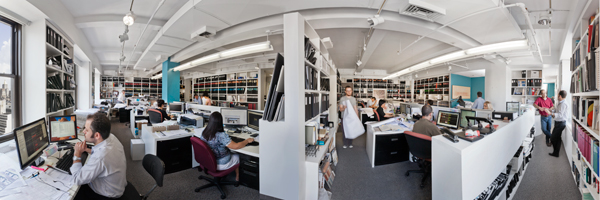Firm
Gavin Macrae-Gibson
Gavin Macrae-Gibson received a Master of Arts degree from Cambridge University in 1977, which he attended as an Anderson-Webb Scholar. He received a Master of Architecture degree from Yale University in 1979, which he attended as a Mellon Fellow. He was an adjunct professor at the Yale School of Architecture from 1982 to 1992, and also taught at Columbia University and the University of Miami. He has lectured at numerous other schools of architecture throughout the United States and Canada.
In 1985 MIT Press published his book The Secret Life of Buildings, an American Mythology for Modern Architecture, subsequently published in a Spanish edition by Editions Nerea in 1991. Macrae-Gibson Architects was opened in 1985 and has been in continuous operation in New York since that date, winning numerous design awards.
Philosophy
Macrae-Gibson Architects specializes in urban architecture and its components. Since its founding in 1982, the firm’s intelligent and pragmatic projects have become imbedded in the texture of Manhattan, quietly strengthening the architectural quality of the city. The firm designs both new construction and renovations for residential, institutional and commercial clients.
Macrae-Gibson Architects has achieved its success by turning the particularly difficult aspects of its urban projects into unexpected, winning solutions. In these transformations of the urban realm, the firm values intellectual rigor over a limiting signature style. Such thoughtfulness enables Macrae-Gibson Architects to focus on creating maximum concentration of meaning in its diverse buildings and interiors.
Residential
The firm’s residential scope ranges from the transformation of raw downtown lofts, to renovations of New York’s historic apartment buildings and townhouses and restorations of, additions to and construction of the vacation homes to which New York escapes. As well, Macrae-Gibson Architects has completed low-income housing developments. Whether the home is a Park Avenue apartment or a housing unit in Newark, the firm lends incisive attention to the architectural demands of the project resulting in high quality, supremely serviceable living spaces that reveal a discerning respect for the building’s history and setting.
Institutional
Macrae-Gibson Architects has worked for some of the foremost institutional clients in New York. Among these are the New York Public Library, for whom the firm has completed the full rehabilitation of the historic Ottendorfer Library, and the restoration of the Astor Hall entrances to the Main Library on Fifth Avenue; Lenox Hill Hospital, for whom the firm is designing the Heart and Vascular Institute, a new building that incorporates six historic townhouse facades, as well as a renovation of and addition to the Manhattan Eye, Ear and Throat Hospital; and the New York City School Construction Authority, for whom the firm has designed some 25 projects, including new Jill Chaifetz High School. From schools to libraries, Macrae-Gibson Architects brings its sensitive attention to the creation of memorable urban infrastructure.
Commercial
The firm has completed many projects for notable companies including new buildings, interiors and public spaces. Among the firm’s clients are: Hartz Mountain Industries, for whom the firm designed the public spaces of Blue Cross Blue/Shield of New Jersey as well as those of New Jersey Transit; Metropolitan Life; New York Life; York/Hunter Construction and Kaufman Management, for whom the firm has recently designed a new 14 story office tower near Pennsylvania Station. The firm’s commercial work not only expresses the structure of a company in outstandingly effective spaces, but finds imaginative ways to adroitly convey corporate imagery.
The Urban Whole
Besides residential, institutional and commercial elements of the city, Macrae-Gibson Architects has enhanced the urban whole with the creation of the public spaces and experiences that a dense city such as New York requires. These include winter gardens, building top illuminations, walking arcades, such as a through block arcade at 35th St which serves as an art-filled, mid-block short-cut; urban parks, such as the Temporary Fashion Museum, made up of architectural versions of garment trolleys, that occupies a plaza in the Fashion District; and façades and playgrounds, such as that of PS 33, which contains play equipment in the form of miniature Manhattan skyscrapers.









